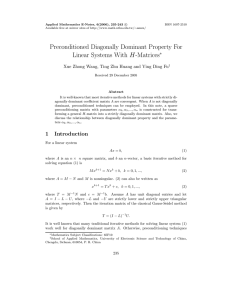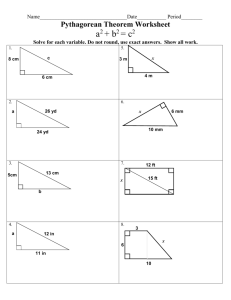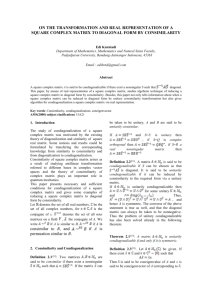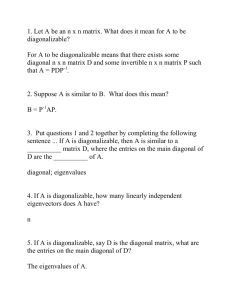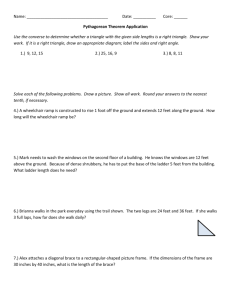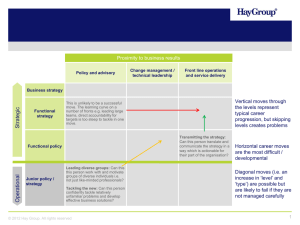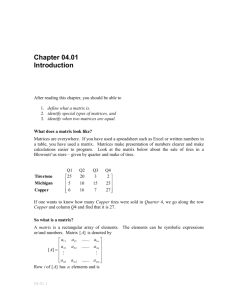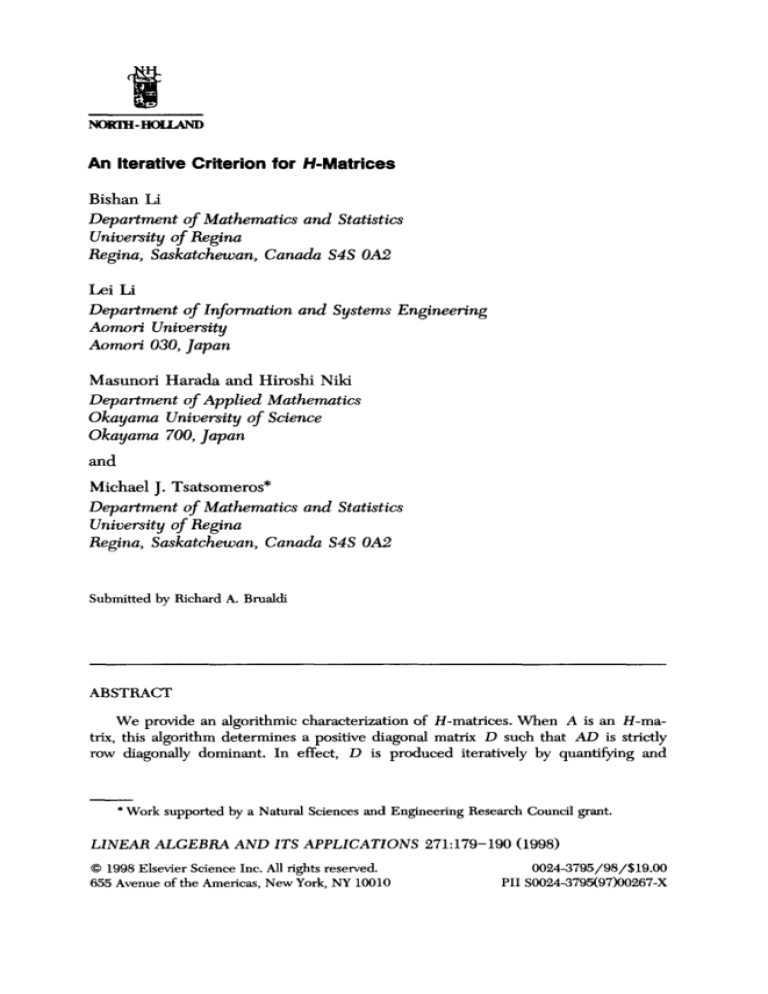
NOR]TI - I-K)UAND
An Iterative Criterion for H-Matrices
Bishan Li
Department of Mathematics and Statistics
University of Regina
Regina, Saskatchewan, Canada $4S OA2
Lei Li
Department of Information and Systems Engineering
Aomori University
Aomori 030, Japan
Masunori H a r a d a a n d Hiroshi Nild
Department of Applied Mathematics
Okayama University of Science
Okayama 700, Japan
and
Michael J. Tsatsomeros*
Department of Mathematics and Statistics
University of Regina
Regina, Saskatchewan, Canada $4S OA2
Submitted by Richard A. Brualdi
ABSTRACT
We provide an algorithmic characterization of H-matrices. When A is an H-matrix, this algorithm determines a positive diagonal matrix D such that AD is strictly
row diagonally dominant. In effect, D is produced iteratively by quantifying and
* Work supported by a Natural Sciences and Engineering Research Council grant.
LINEAR ALGEBRA AND ITS APPLICATIONS 271:179-190
© 1998 Elsevier Science Inc. All rights reserved.
655 Avenue of the Americas, New York, NY 10010
(1998)
0024-3795/98/$19.00
PII S0024-3795(97)00267-X
180
BISHAN LI ET AL.
redistributing the diagonal dominance present in some rows of A to the non-diagonally-dominant rows. © 1998 Elsevier Science Inc.
1.
INTRODUCTION
The H-matrices, defined below, arise in several applications of the
mathematical sciences. The class of H-matrices generalizes the widely studied classes of strictly diagonally dominant matrices and of nonsingular Mmatrices. In this note, we will introduce a simple algorithmic characterization
of H-matrices. We first need to recall the following definitions.
Let A = [aij ] ~ C"' ". We call A generalized (row) diagonally dominant
if there exists an entrywise positive vector x = [xk] ~ C n such that
la,,Ix, >/
Ela,klxk
(i ~ {1,2 . . . . . n}).
(1.1)
k#i
This notion generalizes the notion of (row) diagonal dominance, in which
x = e (i.e., the all ones vector). In fact, if A satisfies (1.1) and if D = diag(x)
(i.e., the diagonal matrix whose diagonal entries are the entries of x in their
natural order), it follows that AD is a diagonally dominant matrix. If the
inequality in (1.1) is strict for all i ~ {1, 2 . . . . . n}, then we refer to the
dominance as strict.
We define next the comparison matrix of A, ,¢t'( A) = [ ~j], by
f lai~l
~J = / -la~jl
if
if
i =j
i #j.
If A = J t ' ( A ) and the eigenvalues of A have positive real parts, we call A a
(nonsingular) M-matrix. We say that A is an H-matrix if -~V(A) is an
M-matrix. For details and numerous conditions equivalent to being an
M-matrix, the reader is referred to [4] and [1].
There are two further remarks we need to make, originating from
well-known facts about M-matrices found in the aforementioned references.
First, every H-matrix, as defined above, is nonsingular. [We caution the
reader that some authors define an H-matrix by what amounts to requiring
that the eigenvalues of ~¢(A) have nonnegative real parts, thus allowing for
singular "H-matrics."] Second, A is an H-matrix if and only if A is strictly
generalized diagonally dominant. Therefore, whether a given matrix A is an
H-matrix or not is equivalent to whether there exists or not a positive diagonal
CRITERION FOR H-MATRICES
181
matrix D such that AD is strictly diagonally dominant. Let us denote the set
of all such positive diagonal matrices by ~ a , SO that
A is an H-matrix if and only if ~ a ~ Q.
Suppose for a moment that A is an H-matrix, and let B =I¢(A), x ~ C n
be an entrywise positive vector, and y = B-1 x. Then, as B-1 is an entrywise
nonnegative matrix (see e.g., [1, Theorem 6.2.3]), y is also entrywise positive.
It follows that D v = diag(y) ~ A " However, the computation of such a
vector y can be an intense numerical exercise, since B-1 is involved.
In [2, Theorem 1], a sufficient condition is given for strict generalized
diagonal dominance of A ~ C n' ". The proof of that result proceeds with the
construction of a matrix D ~-~a" However, the condition in [2] is not
necessary. Moreover, the construction of D depends on knowing a partition
of {1, 2 . . . . . n} for which the sufficient condition is satisfied, making the
computational complexity prohibitive. Similar remarks are valid for the sufficient conditions for H-matrices presented in [6] and [3].
In view of the preceding comments, we find ourselves in pursuit of
another method for computing a matrix in ~ a . Ideally, we want this method
to be computationally convenient, and we also want the possible failure of the
algorithm to produce a matrix in ~A to signify that the input matrix A is not
an H-matrix. In other words, we are in pursuit of an algorithmic characterization of an H-matrix, which can be effectively implemented on a computer.
The algorithm described in the following section has these features.
2.
THE ALGORITHM
Henceforth, given a positive integer n, we note {1, 2 . . . . . n} by ( n ) . Also,
given a matrix X = [xij] ~ C "'", we use the notation
a , ( x ) = ~] Ix,kl
(i ~ ( n ) )
k-~ i
and
NI(X ) = {i ~ ( n ) : l x , I > R,(X)}
and
N2(X ) = ( n ) \ NI(X ).
An algorithmic approach to computing a matrix in ~A was proposed in
[5], where the columns of the mth iterate, A (m), a r e scaled by postmultiplication with a suitable diagonal matrix diag(d). The entries of d ~ C" satisfy
1-
dt =
1
e
(m))
if
i~NI(A
if
i ~ N 2 ( A (m))
182
BISHAN LI ET AL.
Assuming that ~ > 0 is sufficiently small, and that A is an H-matrix, the
algorithm produces a diagonally dominant matrix. Thus the product of the
intermediate diagonal matrices yields a matrix in ~ a . The main drawback of
this method is that the choice of e may lead to a large number of required
iterations. Moreover, when it is not known a priori whether A is an
H-matrix, a possible failure of the algorithm to produce a matrix in ~ a after a
large number of iterations cannot necessarily be attributed to the choice of ~.
We will next introduce a different algorithmic procedure for the computation of a matrix in -@~A,in which the above drawbacks are addressed.
There are two cases where A is easily seen not to be an H-matrix. First, if
A has no diagonally dominant rows, then all the entries of .4g(A)e are
nonpositive, violating the monotonicity condition for M-matrices (see e.g., [1,
Theorem 6.2.3]). It follows that A is not an H-matrix. Second, if a diagonal
entry of A is zero, then A is not an H-matrix, since -~A = O. Consequently,
the algorithm below is designed to terminate (at step 1--before any iterations
take place) if either of these cases occurs. Otherwise, it quantifies the
diagonal dominance in certain rows of the ruth iterate A (m), by computing
the ratios Ri(A(m))/la~'~)l. Then the algorithm proceeds to redistribute the
(collective) diagonal dominance among all rows by rescaling the columns of
A (m), thus producing A (m+ 1).
ALGORITHM DO.
INPUT:
OUTPUT:
i.
a matrixA
= [ag]
E
C n,n a n d
any ~>
D = D(1)D (2) ... D (m) e ~ a if A is
an
H-matrix.
2.
3•
if N I ( A ) = O o r a, = 0 f o r s o m e i ~ <n>,
m a t r i x ', S T O P ; o t h e r w i s e
s e t A (°) = A , D (°) = I, m = 1
c o m p u t e A (m) = A ( ~ - I ) D ( m - D = L[a!I ]m)]
4.
5.
i f N 1 ( A (m)) = <n>,
'A is
s e t d = [di], w h e r e
di
_-
1 -
an
H-matrix
la~)lai(A(m))
la.l(m ) +
1
6.
s e t D (m) = dia#d), m = m + i; g o
0.
'A is n o t
', S T O P ;
i ~ N l ( A (m))
if
i E N2(
step
3
H-
otherwise
if
to
an
A (m))
CRITERION FOR H-MATRICES
183
The theoretical basis for the functionality of Algorithm H as a criterion for
H-matrices is provided by the following theorem and the two lemmata that
precede its proof.
THEOREM 2.1. The matrix A = [aij] ~ C n'n is an H-matrix if and only
if Algorithm H terminates after a finite number of iterations by producing a
strictly diagonally dominant matrix.
LEMMA 2.2. Algorithm H either terminates or produces an infinite
sequence of distinct matrices {A(m) = [a~')]} such that limm_.~la~)l exists
for all i, j ~ ( n }.
Proof. Suppose that Algorithm H does not terminate, that is, it produces
an infinite sequence of matrices. Recall that this means NI(A) :~ O and
aii :/: 0 for all i ~ (n}. For notational convenience, we can assume that
A = . # ( A ) and that
A =
all
--a12
. . . .
aln
--a21
a22
. . . .
a2n
--anl
--an2
...
ann
where ai, > 0 and a i j >1 0 for all i , j ~ ( n ) . By the definition of d i in step
5, it readily follows that for all i ~ NI(A(m)), d i ~ (0, 1) and also that
R,( A (m)) +
d, =
ai7 ) +
Hence, since d, is an increasing function of e ~ [0, ~), we have that for any
m=1,2,...,
a~T+ l)= d.a!m)
-,-,, >
R,( A
a~m)
a~,~)
= R i ( A (m)) ~ B i ( A ( m + l ) ) .
In other words, we have shown that
NI(A) = NI(A (1)) _ NI(A (2)) _ "'" _ NI(A (m)) c_ ....
184
BISHAN
LI ET AL.
Consequently,
there exists a smallest integer I! such that N,( A(“)) = N,( A(‘+r))
for all p = 1,2,. . . . Since Algorithm
W terminates
for the input matrix A if
and only if it terminates
for the input matrix
A(“), we may without
loss of
generality
assume that 1 = 1. Further,
we may suppose that
N,( A) = N,( A(“)
(otherwise
assumption,
= { 1,2,.
. . , k}
we can consider
a permutation
the algorithm
yields
A’“+
1) = A’“@‘“)
for some
similarity
(m
of
k < n
A).
Under
,...,
l]r,
this
= 1,2,...),
where
ZY”)
= diag( d,),
d,=
[d$“‘,d$‘)
and dj”) E (0, 1) for all i E (k).
(&m+l)
st
It follows
sequence.
=
,...,
dim”,,l,l
Thus,
dirn)uty)
if
s E (n)
and
t E N,( A”‘),
a St
if
s E (n)
and
t
E N,( A(l)).
that for any s, t E (n),
{a$)} is a nonincreasing
Thus lim, ~ m u$’ exists for all s, t E (n).
LEMMA 2.3. Zf Algorithm
[a!?)]}, then fir all i E N,(A),
l-4 produces the infinite
and bounded
n
sequence {A(“’
=
Proof. Assume that A is as in the proof of Lemma 2.2, and suppose, by
way of contradiction,
that for some i E N,(A), lim, ~ ,[ uiy’ - Ri( A(‘“‘)] Z 0.
Notice that u$r) > Ri( A(“)), and recall that, from Lemma
2.2, both sequences {a$:)} and (Ri( A(“)} converge. We can therefore
conclude that there
exists E > 0 such that
a{:) - Ri( A’“‘)
> lo
(m = 1,2,...).
(2.2)
CRITERION FOR H-MATRICES
185
In particular, a{~ ) > c 0 + Ri( A (m)) >1 Co. F r o m Algorithm H we then obtain
0 < a (re+l)
-'ii
(m) (m)
~ di
aii
a{~ )
a{~)-------~E[a{~) -- a i ( A ( m ) ) ]
= a{~ )
)
a~ )
+
c°
- - c
Co+C
0
[by(2.2)]
0 = a{~ ) - 0,
where 0 = c0z/(E0 + c). Note that 0 is positive and therefore, as
a n >~ a~]) + O>~ "" > a]"l0 + m O > l m O ,
by letting m -+ ~ we obtain a contradiction.
W e are now able to prove our main result.
P r o o f o f T h e o r e m 2.1. Sufficiency: Suppose that Algorithm H terminates
after k iterations. That is, we have obtained a strictly diagonally dominant
matrix A {k) = A D , where D = D ° ) D ~2) ... D Ck-1) is by construction a positive diagonal matrix. By our introductory remarks, it follows that A is an
H-matrix.
Necessity: Let A be an H-matrix, and assume that A is as in the proof of
L e m m a 2.2. Furthermore, by way of contradiction, assume that Algorithm H
yields the infinite sequences
{ A(m)} ,
{a{~)},
{ R i ( A ( m ) ) },
{NI( A(m))}-
As in the proof of L e m m a 2.2, we can without loss of generality assume that
NI(A ~'))=NI(A)={1,2
. . . . . k} for some k < n and all m = 1,2 . . . . .
Notice that
A~m + ~) = A(m)D (m) = A D O ) D (e) ... D(m) = AFO"),
where F 0'0 is a positive diagonal matrix diag(d m) with d m = [,C(m)
rt'(m) ,
31 ,J2
. . . . f~m), 1, 1 . . . . . 1]r. F r o m L e m m a 2.2, it follows that limm_~= A 0") exists
186
BISHAN LI ET AL.
and s o l i m m . _ , ~ F ~m) also exists. Say these limits are B and F = diam(d),
respectively, where d = [fl, f2 . . . . . fk, 1, 1 . . . . . 1] r. W e thus have AF = B.
Now notice that B is of the form
bu
bl2
....
--bkl -bkz
...
-b~l
....
-b.2
blk
--al, k+l
bkk
--ak,k+
bnr
1
-- an, k + 1
. . . .
a]n
. . . .
akn
"""
ann
where, by L e m m a 2.3, bii = Ri(B) for all i ~ NI(A), and b~i = ai~ <~ Ri(B)
for all i ~ N~(A). H e n c e N I ( B ) = ~ , implying that B is not an H-matrix•
Ct
IM
f l ----f2 . . . . .
fk = 0.
Proof of claim. First, note that if all f~ > 0, then B = AF would be an
H-matrix, a contradiction. So at least one of the f~'s equals zero. Without loss
of generality, assume that f l = f2 . . . . .
fp = 0 for some p < k and that
fq > 0 for all q = p + 1, p + 2 . . . . . k [otherwise we can consider a p e r m u tation similarity of A that symmetrically p e r m u t e s from the first p rows and
columns of A, leaving N I ( A ) invariant]. T h e n B = AF has the block form
AD =
(o
0
=
to *1
Bn_p
= B
where An-p and B n _ p a r e (n - p ) × (n - p). As / t n - p is an H-matrix, so
is Bn_ p. This is a contradiction, because b, <~Ri(Bn_ p) for all i ~ ( n ) \
( p ) . This completes the proof of the claim.
•
W e now have that
t° °/(°0 )
AF = A 0
In_ k
Z~n_k
B
I°
Bn_k
Once again, we have a contradiction because /~n-k is an H-matrix but B n _ k
is not. This shows that Algorithm H must terminate after a finite n u m b e r of
iterations, completing the p r o o f of the theorem•
•
CRITERION FOR H-MATRICES
3.
187
COMMENTS AND A MATLAB FUNCTION
We begin by noticing that the proofs of Lemma 2.2, Lemma 2.3, and
Theorem 2.1 can be easily adapted to the case where the parameter ~ is not
constant throughout the iterations, but instead is independently chosen at the
mth iteration of Algorithm H to form a bounded sequence {~(m)}.
It is clear from the definition of Algorithm H and Theorem 2.1 that the
termination or not of Algorithm H is irrespective of the choice of the positive
parameter ~, or of the bounded sequence {e (m)} as remarked in the previous
paragraph. However, the column scalings and the redistribution of the
diagonal dominance at each iteration are done according to the ratios
Ri( A (m)) + E(m)
la~7°l + e(m)
Also, for 0 < b < a, (b + e.)/(a + e) is an increasing function of E > 0.
Hence, smaller choices of the parameter E (m) result in at least as large a set
N1( A(m+ 1)). Nevertheless, it is not generally true that by choosing e(m) small
enough the number of further iterations required for the termination of the
algorithm is 1, even if A is an H-matrix. To see this formally, let A ~ C"'"
be an H-matrix and suppose that l E N2(A (m)) for some positive integer m.
Observe then that
Rk( A(m)) +
Rz(A(m+x)) =
E
lalT)l + ~
lat~)l +
k E NI( A(ra))
E
k ~ N2(A(m)),
lat~)l •
k~l
So, if the entries of A (m) satisfy
a k ( A (m))
lal~)l +
k~NI(A (m))
la(k'~)l
E
kEN2(A(rn)),
latT)l > lal?)l,
k*l
then at least two more iterations of Algorithm H are required, regardless of
the choice of ~ > 0. We illustrate this situation with the following example.
188
BISHAN LI ET AL.
EXAMPLE 3.1.
Consider the H-matrix
A =
4
-1
1
1
3
1
-1)
1 ,
-1
and notice that NI(A) = {1, 2}, N2(A) = {3}. As
lim
]~
Rk(A) + •la3k I = lim
~ 0 + k~N~(a) lakkl + •
,--,0+
- -
+
4 + •
> 1=1a331,
3 +
it follows that a first pass of Algorithm H will not result in a strictly diagonally
dominant third row. That is, at least two iterations are needed for the
algorithm to terminate by producing D ~ ~A, regardless of the choice of
• > 0. In fact, for • = 0.1 exactly two iterations are needed.
Let us now consider some practical aspects of choosing the parameters
• (m). AS is done for example in Matlab, let E denote the floating point
relative accuracy, namely, the distance from 1.0 to the next largest floating
point number (E = 2 -52 = 2.2204E -- 16 on machines with IEEE floating
point arithmetic). Choosing •(m) optimally does not mean that we should
choose •(m)= E, because we must ensure that when a diagonal entry is
scaled down, the corresponding row remains strictly diagonally dominant
within the machine's working precision. Instead, we must choose •(m) SO that
for all k ~ NI(A(m)),
Rk ( A(m)) + •(m)
la(k,~)l + •(m)
la~'~)1 - - Rk(A(m)) > E,
or equivalently,
Ela~)l
• (m) > la~T)l_ n k ( A ( m ) ) _ E "
(3.3)
For example, we may choose "optimal" parameters •(m) by
• ,m) =
max
k E N l ( A (m))
so that (3.3) is satisfied.
E(Ia~T)I + 1) )
la~'~ - - - ~ A -~))
(3.4)
CRITERION FOR H-MATRICES
189
The next practical aspect of Algorithm H we want to discuss is the
situation when the input matrix A ~ C n'n is not (known to be) an H-matrix.
When the computed diagonal matrix D (m) is approximately equal to the
identity (and the algorithm has not terminated), it means that the present
iterate is not diagonally dominant and there is little numerical hope that it
will become one. Based on Theorem 2.1, we can then stop and declare that
A is not an H-matrix.
We also comment that Algorithm H can be modified so that step 6 takes
place every time an i ~ NI(A (m)) is encountered; then it proceeds by
searching for the first index in NI(A(m+I)). This usually results in fewer
iterations until a matlSx D ~ ~A is found.
Finally, we provide a Matlab function implementing Algorithm H with a
fixed parameter e. The termination criteria regarding the computation of a
D ~.~A or the decision that A is not an H-matrix are handled by the default
relative accuracy of Matlab:
function [diagonal,m]=hmat(a,
epsilon, maxit)
% INPUT: a = s q u a r e m a t r i x , e p s i l o n = p a r a m e t e r
of re% distribution
% maxit=maximum
n u m b e r of i t e r a t o n s a l l o w e d
% OUTPUT: m=number
of i t e r a t i o n s p e r f o r m e d ,
% diagonal=diagonal
m a t r i x d so that a d is s t r i c t l y
% diag. d o m i n a n t
%
= [ ] (if a is not an H - m a t r i x )
n= size(a,l); diagonal=eye(n);
m=l; one=ones(l,n);
stoppage = 0 ;
if ( n a r g i n = = l ) ; e p s i l o n = .001; m a x i t = 1 0 0 ;
end
if ( n a r g i n = = 2 ) m a x i t = 1 0 0 ;
end
if ( 1 - a l l (diag(a)))
stoppage=l;
diagonal=
[ ]; m = m I; ' 'Input is N O T
a n H- m a t r i x ',
end
while (stoppage==0 & m<maxit+l)
for i = l : n
r(i) = s u m ( a b s ( a ( i , l : n ) ) ) - a b s ( a ( i , i )
);
if (abs (a(i,i)) >r(i) )
d(i) = (r(i) + e p s i l o n ) / ( a b s ( a ( i , i ) ) + e p s i l o n )
;
else
d(i) =i;
end
end
190
BISHAN LI ET AL.
if ( d = = o n e )
s t o p p a g e = i; d i a g o n a l = [ ]; 'Input is NOT an Hm a t r i x ',
elseif (d<one)
stoppage=l;
'Input IS an H - m a t r i x ',
else
for i = l:n
diagonal(i,i)=diagonal(i,i)*d(i);
end
a=a*diag(d); m=m+l;
end
end
if ( m = = m a x i t + l
&stoppage==O)
d i a g o n a l = [ ]; m = m - i '
'Inconclusive: d e c r e a s e ''epsilon '' or i n c r e a s e
''maxit '',
end
REFERENCES
1 Abraham Berman and Robert J. Plammons, Nonnegative Matrices in the Mathematical Sciences, Classics Appl. Math., SIAM, 1994.
2 Yi-ming Gao and Xiao-hui Wang, Criteria for generalized diagonally dominant
matrices and M-matrices, Linear Algebra Appl. 169:257-268 (1992).
3 Yi-ming Gao and Xiao-hui Wang, Criteria for generalized diagonally dominant
matrices and M-matrices. II, Linear Algebra Appl. 248:339-353 (1996).
4 Roger A. Horn and Charles R. Johnson, Topics in Matrix Analysis, Cambridge
U.P., 1991.
5 M. Harada, H. Niki, and M. Usui, An extension of the criteria for generalized
diagonally dominant matrices (II), in Proceedings of the Annual Symposium of
the Japan SIAM, 1995, pp. 280-281. (in Japanese)
6 Huang Tin-Zhu, A note on generalized diagonally dominant matrices, Linear
Algebra Appl. 225:237-242 (1995).
Received 5 June 1996;final manuscript accepted 3 June 1997


